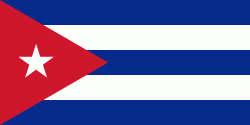Guanabacoa
Guanabacoa is a colonial township in eastern Havana, Cuba, and one of the 15 municipalities (or boroughs) of the city. It is famous for its historical Santería and is home to the first African Cabildo in Havana. Guanabacoa was briefly the capital of Cuba in 1555 after Havana was attacked by French pirate Jacques de Sores. This gave rise to the Cuban saying “Like putting Havana in Guanabacoa,” which is used to describe trying fit something too large into a space too small. Guanabacoa was the site of the Battle of Guanabacoa, a skirmish between British and Spanish troops during the Battle of Havana during the Seven Years' War.
The town of Guanabacoa is situated in the province of La Havana, some five kilometers (3.2 miles) to the southeast of La Havana (city) and south of the city of Regla. It rests on a small hill bordered by rivers.
Guanabacoa was also the home of a small community of Florida Indians, mostly Apalachees and Yamasees, who, along with Spanish forces, were evacuated from Florida in 1764, following the conclusion of the Seven Years' War.
The town of Guanabacoa is situated in the province of La Havana, some five kilometers (3.2 miles) to the southeast of La Havana (city) and south of the city of Regla. It rests on a small hill bordered by rivers.
Guanabacoa was also the home of a small community of Florida Indians, mostly Apalachees and Yamasees, who, along with Spanish forces, were evacuated from Florida in 1764, following the conclusion of the Seven Years' War.
Map - Guanabacoa
Map
Country - Cuba
 |
 |
| Flag of Cuba | |
The territory that is now Cuba was inhabited by the Ciboney people from the 4th millennium BC with the Guanahatabey and Taíno peoples until Spanish colonization in the 15th century. From the 15th century, it was a colony of Spain, and slavery was abolished in 1886, remaining a Spanish colony until the Spanish–American War of 1898, when Cuba was occupied by the United States and gained independence in 1902. In 1940, Cuba implemented a new constitution, but mounting political unrest culminated in a coup in 1952 and the subsequent dictatorship of Fulgencio Batista, which was later overthrown in January 1959 by the 26th of July Movement during the Cuban Revolution, which afterwards established communist rule under the leadership of Fidel Castro. The country was a point of contention during the Cold War between the Soviet Union and the United States, and a nuclear war nearly broke out during the Cuban Missile Crisis of 1962. Following the collapse of the Soviet Union, Cuba faced a severe economic downturn in the 1990s, known as the Special Period. In 2008, Fidel Castro resigned after 49 years of leadership of Cuba and was replaced by his brother Raúl Castro.
Currency / Language
| ISO | Currency | Symbol | Significant figures |
|---|---|---|---|
| CUC | Cuban convertible peso | $ | 2 |
| CUP | Cuban peso | $ | 2 |
| ISO | Language |
|---|---|
| ES | Spanish language |















